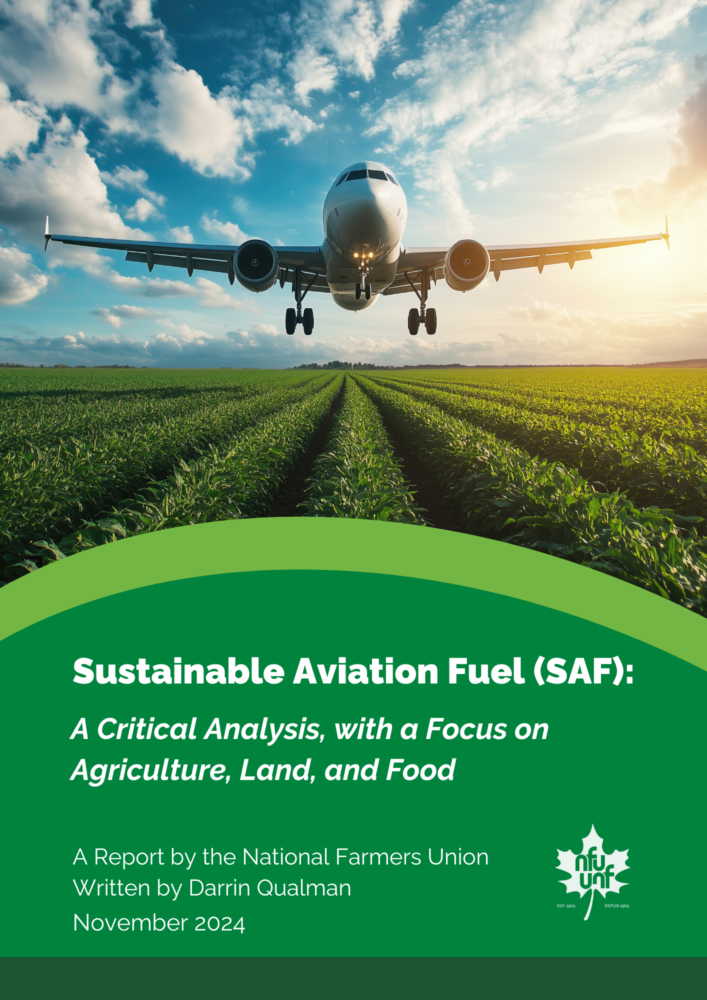Sustainable Aviation Fuels (SAFs) are lower-emission, non-fossil-fuel energy sources for the world’s aircraft fleet—“drop-in” fuels that require no modifications to aircraft or engines. The proposal is to make SAFs largely from biological sources: corn, soybeans, and canola now and over the next decade or so, and then increasingly from straw and other “agricultural residues” and from purpose-grown energy crops such as grasses or fast-growing trees (with a minor portion from forestry residues). There is a third phase proposed: to use clean renewable energy to extract hydrogen from water and carbon from the air and combine these into a liquid fuel. But such “Electro-fuels” remain speculative and the very high costs and energy requirements suggest they may remain unfeasible.
Why should citizens and policymakers be concerned about SAFs? Because the immense scale of the global SAF project creates significant potentials to move us away from many of our food system, climate, decarbonization, sustainability, and social justice goals. At the same time, the huge, global SAF project may fail in its stated intent: to slash greenhouse gas (GHG) emissions and warming effects from a rapidly expanding aviation sector.
Citizens want affordable food and sustainable food systems. Farmers want to maximize soil carbon sequestration and begin to reduce emissions from fertilizer use. We all want to be able to develop renewable energy supplies that are adequate to the tasks of decarbonizing home heating, motor vehicle travel, and industry. The global SAF project risks moving us away from all these goals: it will likely raise food prices; reduce the sustainability of food systems; slow or reverse agricultural soil carbon sequestration; drive up fertilizer use and attendant agricultural GHG emissions; and put impossible-to-meet demands onto limited supplies of clean, renewable energy thereby slowing emissions reduction in other sectors.
If governments continue to encourage and subsidize the SAF megaproject, those governments risk “policy incoherence”—pursuing policies that work directly against the attainment of other policies and social and environmental goals. SAFs attempt to solve one problem but create many larger problems.
More important, there are reasons to question whether the SAF megaproject is even possible. Is it real? Or is it a distraction which will delay more effective emission-reduction measures and direct trillions of dollars toward the wrong investments and away from superior alternatives? Worse than a huge global project that increases food prices and on-farm emissions while solving an aviation emissions problem is a project that creates those food and farming problems while simultaneously failing to slash aviation emissions. That latter scenario is a significant probability. Considered within the context of planetary boundaries, limited resources and trade-offs, and the need to simultaneously solve multiple climate and sustainability problems—to tackle the polycrisis—the global SAF project (which includes doubling air travel) may simply be impossible. At the very least, the project raises so many questions and affects so many other parts of the economy and biosphere that every policymaker and citizen should want to learn more.
We are in a climate emergency which requires near-wartime-levels of action on the part of all governments and citizens. It requires rigorous, holistic, long-term thinking; hard choices; the acknowledgement of trade-offs and limits; wisdom; and bold, courageous action. No matter what the fuel source, doubling or tripling air travel by mid-century is incompatible with any responsible, science-based assessment of the challenges and trade-offs we face or the painful and damaging impacts already occurring and set to multiply in coming decades. And any plan to fuel that doubling of air travel largely from the planet’s oversubscribed land base reveals an ignorance of the magnitude by which we have already transgressed planetary boundaries—how far we have already moved outside the “safe operating space for humanity” when it comes to nitrogen and phosphorus flows, land use change, species extinction, and biomass removal.

